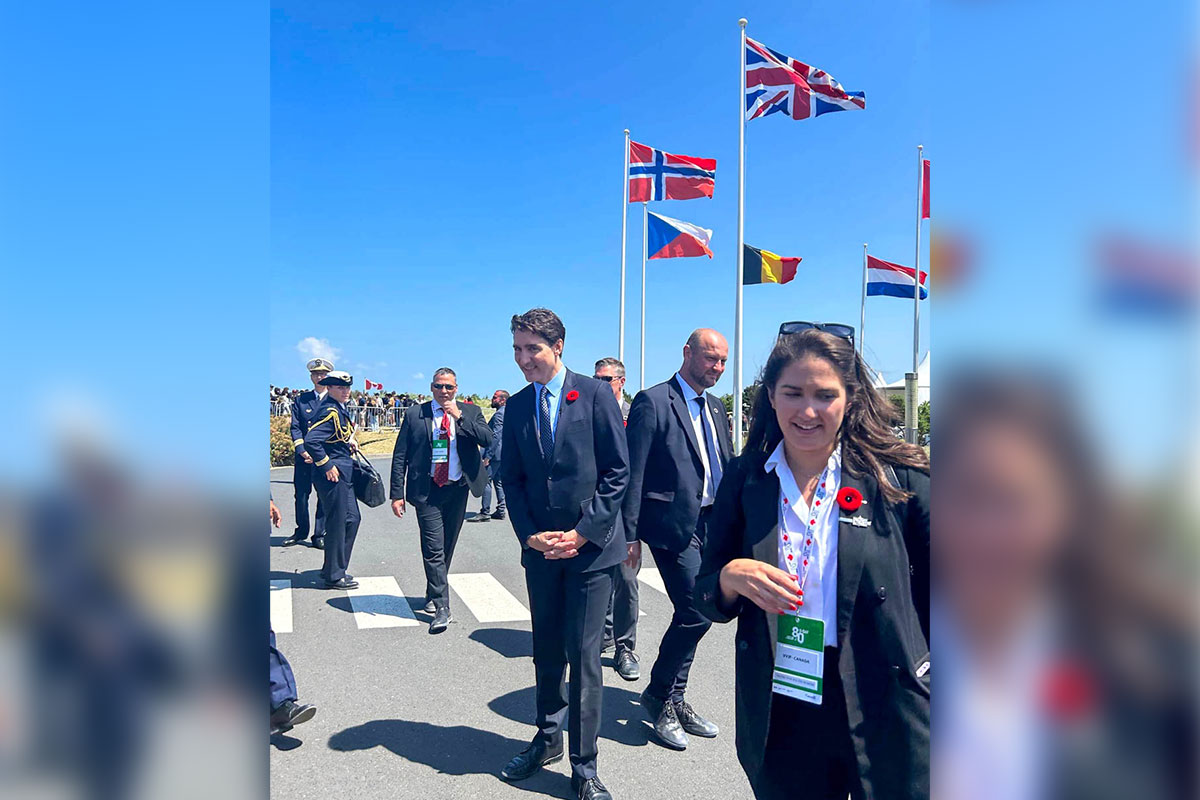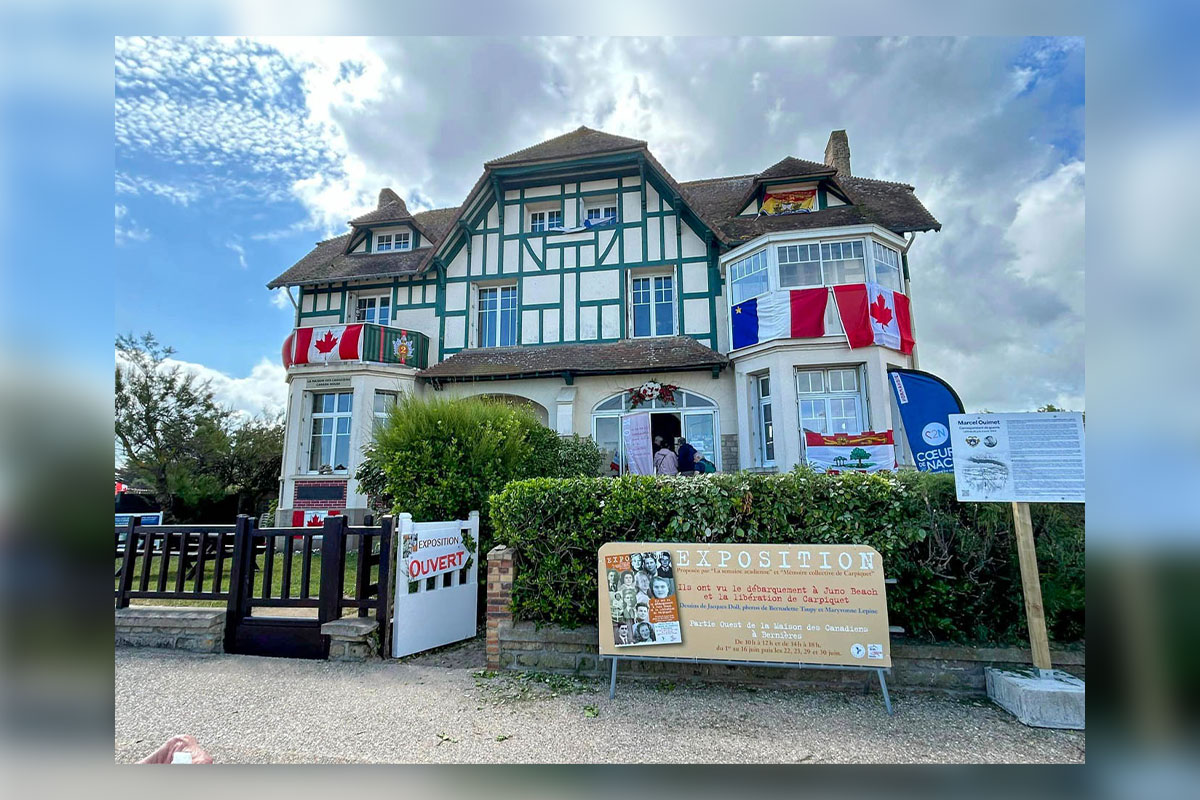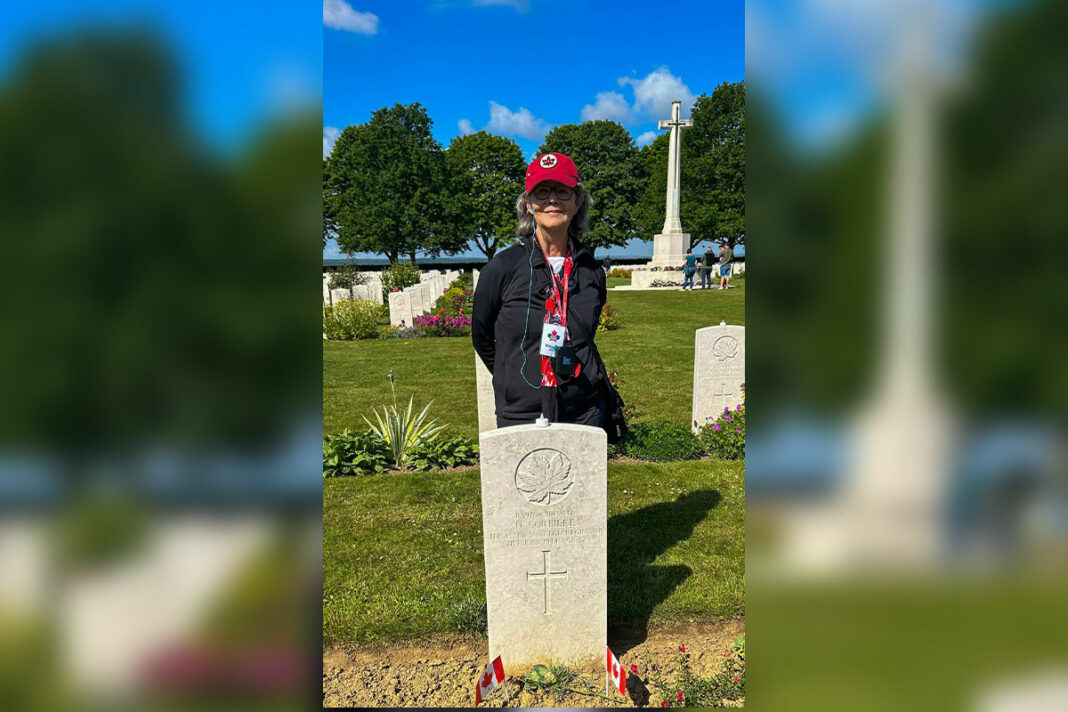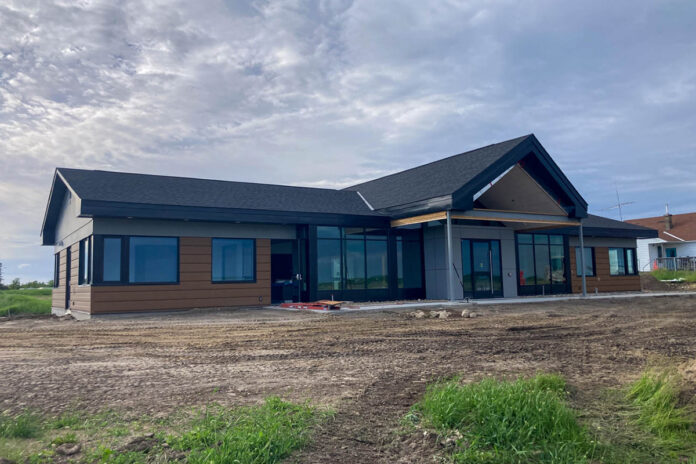NORMANDY, FRANCE—With parachutists floating down from the heavens and military jets roaring overhead, crowds numbering in the tens of thousands gathered on the beaches of Normandy to commemorate the June 6, 1944 Allied landings that heralded the liberation of Europe from the grip of Nazi oppression. Manitoulin residents may have noticed the absence of our own Roy Eaton, a regular fixture at Legion events, from the Decoration Day observances this year—the reason is he and his wife Margaret were among those thousands standing sentinel at Juno Beach.
“We were in a very bad position,” he noted. “We got there two hours ahead of everything and there were 10,000s of people. We found a little spot for our crew way over on the side and we were looking directly into the sun at a smaller screen. So, you know, the experience was not as great as it could be. Probably the best thing was the parachuters coming down. I took a video.”
The trip was far from a disappointment, however. “What impressed me more, and it was not that segment, but what we’ve been through for the last five days.”
“The last number of days that we’ve been here, as we go to each of the three beaches, we have three superb historians,” said Mr. Eaton. “One in particular is an actor, so when he talks, it just comes alive.”
The beginning of the group tour that Mr. Eaton and his wife are on began with a showing of the first seven minutes of the acclaimed war film ‘Saving Private Ryan.’ “Opening with one of the landing craft letting down the opening door and every single person inside the landing shot being killed—and then it goes on. It really brought it alive.”
The tour then travelled to the different beaches—Sword, Utah and Juno. “That film was certainly in my mind, in everybody’s mind, the reality of what we were there for,” said Mr. Eaton. “My Uncle George, who lived in Whitefish Falls, was with the Queen’s Own Rifles.” The Queen’s Own Rifles were part of the Canadian 3rd Division, the only Canadian division to land on the first day of the assault.

“At Juno Beach we were standing in front of Canada house (the first house liberated by the Canadians at Juno Beach),” he said. And we learned, if we had a family member, we could turn that information into the historians and they checked out some things. And then as they did different things at different beaches and different activities, they would call your name out and read about your relative. So, there we were in front of Canada house—the first liberated house by the Canadians with the beach right behind us and they were just talking about my Uncle George. You know, that was so powerful.”
“One of the things that also really struck me in a very different way, is that we just happened to luck into having these 100-year-old veterans here at the hotel we are staying in,” said Mr. Eaton. “We had a group of them and I had a chance to talk to these people. This morning, I go down and this young 99-year-old says ‘you got to meet my friend. My friend is the oldest veteran in the world from World War II, as far as we know—107 years old.’ I shook his hand and talked to him and his buddy.”
Mr. Eaton discovered to his amazement that American Airlines chartered one of their planes and they put 200 people on it—veterans and their caretakers.

“They had a choir made up of veterans from five different services that tours America, and then, on top of it, they had a youth choir made up of cadets and midshipmen. They had their own medical staff traveling with these people and, oh man, is that something. And to actually have your picture taken with them—spend some time talking to them—well, it was you know really, really moving.”
“The other thing that was really meaningful to us, was that as we were in Juno, we found the very first plaque that we ever saw on monuments to Indigenous people,” said Mr. Eaton. The moment was very special given that Margaret Eaton’s grandmother’s brother, from Aundeck Omni Kaning, was killed during the invasion.”
One of the people on the tour is making a video about the experience and he ended up interviewing Margaret.
“In two days’ time, we’re going to be at the War Memorial graveyard and he’s buried there,” said Mr. Eaton. “So, Margaret’s going to get a chance and as far as we know she might be the first person from Manitoulin Island to find his grave.”
“On D-Day, we got up a little after 5 am and the roads were blocked,” he said. “The bus driver had to turn around. We waited a long time and when we finally got there, it reminded me when Margaret and I were in England when the queen died, I mean immense, immense lines and we all had to go through security. Well anyway, while we’re standing there, there’s this group of young girls, teenagers with their chaperones, all wearing ribbon skirts.”
Mr. Eaton, a retired school principal, talked to them and discovered the youths were from Manitoba, “mainly from Winnipeg but across Manitoba and they were with Educational Tours. Later on, I talked to one of the people who was with Educational Tours and asked how many children they looked after,” he said. “They said, ‘we have 800 students from across Canada.’ Wow, I couldn’t believe it.”
The tour company had arranged for the group to purchase folding chairs for the D-Day commemorative event. The group of Canadians had planned to donate the chairs to the Juno Centre, but the museum could not accommodate them, so they donated them to their hotel.
Being familiar with the Metis sash, Mr. Eaton noticed one group who were wearing the garment.
“I went over and took pictures of some young girls and talked to them,” he said. “The Metis Federation of Manitoba sponsored all these people, all these young people and, obviously their chaperones, to come and be part of the ceremony.”
And then, “hearing our governor general speak in Oji-Cree, it’s pretty special for us,” he said.
Another amazing opportunity came when “Margaret and I had some private time with one of the guides because people were doing other things,” said Mr. Eaton. “He showed us where these gliders came down ‘that glider landed here, this one, it went into the swamp and one man drowned, and then they got up they had to capture this bridge, and over here, see where the pill box was—and you can see it. Well, I mean the whole thing is alive to us now.”
Mr. Eaton said that one of the things that really struck him was the number of military personnel who are there from all of the Allied countries and the reenactors wandering about in full period kit. “This actor came around and he must have had 80 to 100 lbs of equipment that he was carrying with his huge long antenna, batted down,” said Mr. Eaton. “And that’s what this guy had to do, to do his broadcast and I thought, carrying that, going through the surf. Coming in, bullets flying, like how do you do that?”
“This elderly man and woman were dressed very nicely, and I asked them ‘Were you or your family involved in the French resistance?’ and they were. They were young children at the time, but in halting French we talked about that. I thought that was neat.”
The Eatons also met up with a group of Polish nurses.
“One woman I talked to was a captain,” he said. “And they made kind of fun of her when she said, ‘I was captain.’”
The tour also went to a German war cemetery.
“I guess what happened when the war ended, the Allied troops were buried there in this huge, huge field,” he said. “And then the War Graves wanted to set up a special field, and do it the right way, so all of the graves, all of the bodies, were taken out and moved. So, now you got this empty field. Well, the equivalent grave commission in Germany approached the French government, or whoever, and they ended up burying around 22,000 or something German soldiers.”
The German gravemarkers are quite different from those of the Canadian and other Allied dead, which are standing white tombstones.
“These are totally flat,” he said. “Probably about a foot-by-a-foot. And there is this gigantic field filled with these small things. They had a museum there that we learned about the Germans and how they got young people to volunteer during the summer to bury the dead.”
The cemetery is filled with trees that were planted to symbolize peace.
“The war was a terrible thing,” said Mr. Eaton, “but now we have to work together. They had a lot of symbolism for peace and working together.”
Ms. Eaton’s great uncle was Dominic Corbiere. “As far as we know, he is the only person from Aundeck Omni Kaning buried there,” said Mr. Eaton. “He was with the Scottish Regiment.”
“He was with the Scottish regiment,” interjects Ms. Eaton. “My uncle was with the Queen’s Own Rifles.”
Mr. Eaton is on a special mission while taking in the sights and sounds connected with the 80th anniversary of D-Day. “I’ve had a number of people who bought bricks in the Juno Center (commemorative wall) and they’ve asked me to try to find and take a picture of the brick. I’ll do my best to do that.”
Mr. Eaton and his wife still had several things remaining on their tour over the next few days, and most of their experiences are chronicled on Mr. Eaton’s Facebook page.





